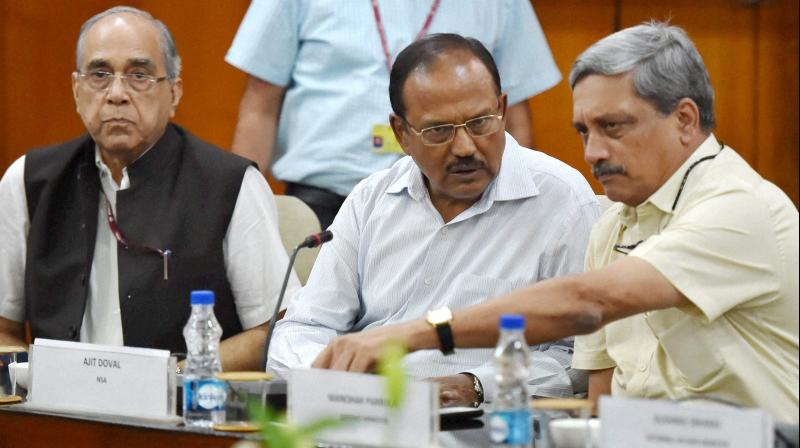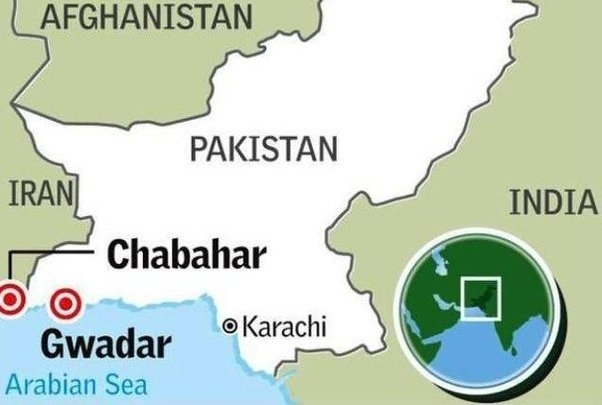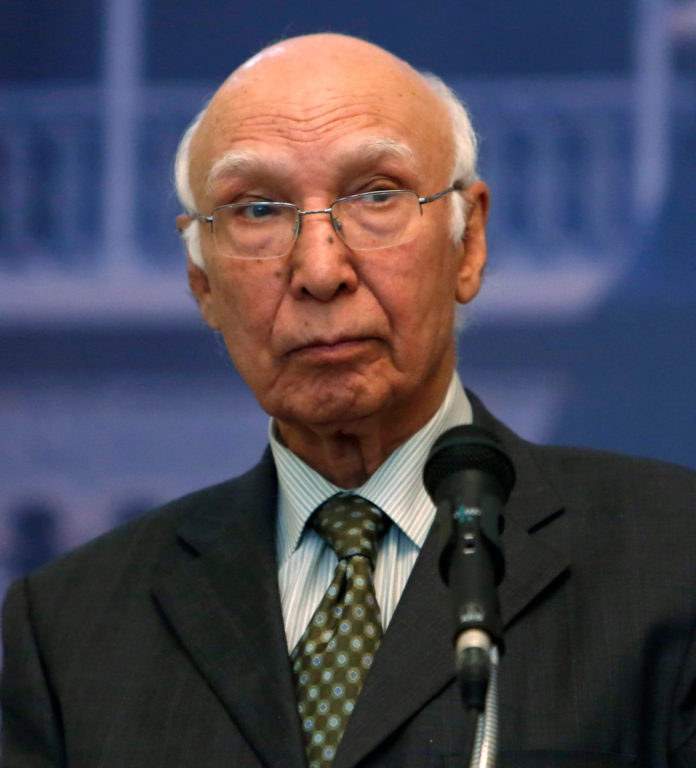India has long cherished the dream of becoming a hegemonic power in the region, to achieve regional preponderance; New Delhi has employed both soft and hard power to bring all the peripheral South Asian countries under its military and economic influence. For India, economically and militarily rising Pakistan has continued to pose a potential threat to its military superiority in the region. “India has always tried to maintain its “hegemony” in the South Asian region and Pakistan has rejected this while “effectively” protecting its interests”, said Sartaj Aziz, the Prime Minister’s Adviser on Foreign Affairs in his interview with Samaa TV in June 2016.
To overwhelm Pakistan, the Indian ‘Cold Start’ doctrine, the disruptive water war and the diplomatic offensive to label Pakistan with terrorism have failed. When all these ill-conceived designs yielded no results, the Modi government tasked its hawkish National Security Advisor Ajit Doval with the mission to weaken Pakistan internally through a multi-pronged proxy war.
Ajit Doval along with Indian Defence Minister Manohar Parrikar has calibrated the infamous ‘Doval doctrine’. This is a disruptive intelligence warfare primarily designed to foment insurgency in Balochistan, ethnicity in Sindh, militancy in southern Punjab and terrorism in the tribal areas of Pakistan. The Indian intelligence agency, RAW has been tasked to clandestinely execute the main points of the Doval doctrine. On 03 November 2016, the Pakistan Foreign Office had said: “As you are aware, a number of Indian diplomats and staff belonging to Indian intelligence agencies RAW and IB have been found involved in coordinating terrorist and subversive activities in Pakistan under the garb of diplomatic assignments”.
Under Ajit Doval’s direction, RAW’s newly-appointed head Anil Dhasmana has premised the agency’s operational strategy on the ancient adage that the enemy of my enemy is my friend. Since the beginning of Operation Zarb-e-Azb, the Indian spy agency has provided financial resources and sophisticated equipment to Pakistani terrorists, militants and insurgents ensconced in Afghan provinces of Nangarhar, Kunar, Nuristan and Badakshan. Kulbhushan Yadav, the operative of RAW in Pakistan revealed in his six-minute video that: “RAW is involved in some activities related to the Baloch liberation movement within Pakistan and the region around it.”

Both Mr. Doval and Mr. Parrikar are fully acquainted with the fact that RAW cannot optimally maximise its malicious operations against Pakistan without intelligence support of the National Directorate of Security (NDS), the Afghan intelligence agency. Since the NDS has an axe to grind it has provided RAW a carte blanche to use some strife-torn areas in eastern Afghanistan as a springboard to sponsor and monitor terrorist and militant networks inside Pakistan. “The Karzai administration open-heartedly offered India an opportunity to establish its terror recruitment camps against its traditional enemy, Pakistan. This was a golden opportunity where India trained its fighters and sent them to Pakistan to carry out suicide attacks”, wrote Musa Khan Jalazai, the author of ‘Fixing the EU Intelligence Crisis’, in his opinion titled “India’s intel war in Balochistan,” carried by Daily Times on December 5, 2016.
One can also recall the remarks of ex-American Defence Secretary Chuck Hegel who in his discussion on Afghanistan had remarked that India had been using strife-torn Afghanistan as a second front against Pakistan and over the years created problems for Pakistan.
Besides this, the Afghan intelligence agency has facilitated RAW’s infiltration into the disillusioned Afghan expats nestled in Pakistan. These disgruntled refugees are indoctrinated and then used to carry out terrorist attacks in Pakistan. In May 2016, Balochistan Home Minister Sarfaraz Bugti had said that Pakistan’s security and intelligence agencies had arrested six operatives of Afghan intelligence agency involved in terrorist activities. He added that the suspects, most of them Afghan refugees, were planted by Afghan intelligence agency National Directorate of Security and Indian intelligence RAW and had confessed to killing more than 40 Pakistanis in various acts of terrorism.
Some vexing questions can be raised on the RAW-NDS nexus: Why is the NDS offering a hand to its Indian counterpart to create insecurity and instability in Pakistan? What are the main objectives behind RAW’s increasing flirtation with Pakistani-based terrorist, insurgent and militant outfits in the region?
With insufficient financial resources and military incompetence, cash-strapped Afghanistan is unable to make the NDS an effective intelligence agency. Due to lack of professionalism and monetary resources, the NDS has fared badly in terms of supplying timely intelligence information to the underperforming Afghan National Army. This has prevented the Afghan law-enforcement agencies from conducting intelligence-based operations against the Islamic State-Khorasan (IS-K), the Islamic Movement of Uzbekistan (IMU), the East Turkmenistan Islamic Movement (ETIM) and the Afghan Taliban — which are based in Afghanistan. Therefore, the NDS supports RAW against Pakistan to receive requisite financial and military assistance from New Delhi.

Most Afghan political elite have not yet recognised the porous and vulnerable Durand Line as an international border between Pakistan and Afghanistan. They still lay claim on some Pashtun-dominated northwestern areas of Pakistan as an integral part of Afghanistan. Reacting to the merger of Federally Administered Tribal Areas (FATA) with Khyber Pakhtunkhwa (KPK), former president of Afghanistan Hamid Karzai said on March 5 this year that: “The government of Pakistan has no legal authority to dictate terms on the Durand line,” adding, “I want to remind the Pakistani government that Afghanistan hasn’t and will not recognize the Durand Line.” But, Islamabad has repeatedly rejected this claim. To achieve this objective, the NDS has joined hands with RAW to arouse nationalist and ethnic sentiments in Pakistan’s marginalised Pashtun population.
Afghanistan has repetitively blamed Pakistan for sheltering the notorious Haqqani Network and the Quetta Shura of the Afghan Taliban. The Afghan leadership often points an accusing finger toward Pakistan’s policy of strategic depth aimed at sponsoring some ‘vetted Afghan Taliban’ to counter the rising Indian economic and military clout in Afghanistan. In retaliation, the NDS has partnered with RAW to harbour Pakistani terrorists and militants in eastern Afghanistan.
As far as Indian designs behind the regional spy warfare are concerned, the Modi government has assigned RAW with the task to scuttle the completion of the China-Pakistan Economic Corridor (CPEC). “India’s intentions about CPEC became crystal clear from the statement of Indian Prime Minister, Narendra Modi in China where he vehemently bashed CPEC and called the project unacceptable,” added Jalazai.
For this purpose, a special cell has been established at the RAW’s headquarters in New Delhi. The cell is entrusted with the sole responsibility to sponsor terrorism and fuel insurgency in Pakistan in order to slow down the progressive works on the grand economic corridor. The detained RAW agent disclosed that the main purpose of his entire intelligence operation was to revive the separatist insurgency in Balochistan and disrupt CPEC. As disclosed by Kulbhushan Yadav, the spy network of RAW against Pakistan stretches from south-eastern Iran to eastern Afghanistan. Yadav said that he had set up a small business in Iran’s southeastern port of Chabahar in 2003, in an effort to avoid detection.
Why is Indian bent on subverting CPEC? Indian military strategists are apprehensive that China will rely on the Gwadar Port to increase its naval presence in the Arabian Sea and near to the Strait of Hormuz. They feel that China will bank on its burgeoning trade with the oil-rich Middle East through the economic corridor to expand its military power. No doubt, such naval presence will greatly help China to protect its main sea lines of communication (SLOCs), especially from the Indo-US bloc.

Apart from this, India unnecessarily deems CPEC and the Gwadar Port largely competitive and obstructive to the Indian-funded Chabahar Port. New Delhi has invested millions of dollars in the construction and up-gradation of this Port so as to augment its trade with Iran, Afghanistan and the Central Asia Republics (CARs). To the Indian government, the Gwadar Port and future expansion of CPEC will overshadow the Chabahar Port, thus helping Pakistan and China to dominate the Iranian, Afghan and Central Asian markets.
The RAW-NDS network is also calculated to create debilitating insecurity in Pakistan so that some Western countries can remain increasingly worried about Pakistan’s nuclear programme. Since the US shares India’s objective, the CIA might be working with RAW to exacerbate Pakistan’s already fragile security situation. In this hybrid warfare, India has extensively lobbied in some Western capitals to stop them from supporting Pakistan on the nuclear front.
It is laudable that the security establishment of Pakistan has managed to counter the offensive of the RAW-NDS nexus in the country. After dismantling the spy network under Kulbhushan Yadav in 2016, the ISI and the Army have continued to conduct operations against the presence of RAW’s operatives in the country.
In this Indo-Afghan intelligence warfare, it is imperative for Pakistan to break the nexus between the NDS and RAW. In this regard, the government should assure Afghanistan of stringent measures against the Afghan Taliban and the Haqqani terrorists in Pakistan. To complement this step, Islamabad ought to reset its economic and political relations with Kabul; the broader economic connection between the two countries will goad Afghanistan into breaking the NDS’s connivance with RAW.
Pakistan cannot completely neutralise the threat of RAW without enhancing intelligence coordination with the Ministry of Intelligence and Security (MOIS) of Iran. Some of RAW’s operatives are believed to be working at the Chabahar Port as Indian engineers and servicemen. If both Pakistan and China include Iran in the CPEC, Tehran would not allow RAW’s agents to use its soil against Pakistan.
Presumably, the most effective means to defuse the ongoing Indian proxy war against Pakistan is to build the capacity of the civil and military intelligence agencies so that they can promptly respond to security challenges of the country.




